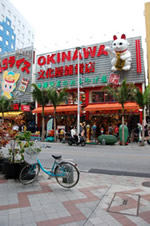Kids Web Japan
Web Japan > Kids Web Japan > Travel > Tropical Cycling Tour > Yachimun Street to Kokusai Street
Travel
Tropical Cycling Tour
From Tsuboya Yachimun Street to Kokusai Street
Tsuboya Yachimun Street

Traditional red-tiled houses still remain on Yachimun Street

A well that used to provide essential drinking water
In the Okinawan dialect, yachimun means �pottery.� Yachimun Street is paved with stones and is home to more than 30 pottery shops. This area has noborigama (stepped kilns built on slopes) said to be about 300 years old and old-style red-tiled houses. The stone paved streets here make riding a bike bumpy and uncomfortable, so be careful.
Noren Market

The Noren Market opens before sunrise.
You will come to Route 330 at the end of Tsuboya Yachimun Street. Turn right on Route 330 and ride south. Turn right at the third traffic light. You will come to a quiet residential area which will prove quite a contrast to the hustle and bustle of Route 330. Be sure to watch for cars that may be turning onto the road from side streets. You'll see the grounds of a middle school on the right, then you�ll come to a small crossroads. Continue straight and on your right you will see the Noren Market, which sells farm produce.
Kainan Seseragi Street

The pleasant and cool tree-lined Kainan Seseragi Street
Go past the Noren Market and turn left. Then, turn right on Kainan-hondori Street and you will come to the Kainan Intersection. Kainan-hondori also goes by the name Butsudan-dori ("Buddhist Altar Street"), after the shops on this street that sell Buddhist altars and trinkets. Turn left at the Kainan Intersection and go down Kainan Seseragi Street. Though seseragi actually means "stream," little remains of the stream that used to run along the right side of this street. However, this tree-lined street is a great place to ride a bicycle.
Kokusai Street

The 1.6 kilometer-long Kokusai Street
Turn right at the Naha High School Intersection and go down Matsuo Shobosho Street (Matsuo Fire Station Street) until you come to Kokusai Street. The approach to Kokusai Street is a downhill slope, so watch your speed. Turn left onto Kokusai Street. Kokusai Street (meaning "International Street") is Naha�s main thoroughfare and is home to numerous souvenir shops and fascinating sights, such as the giant cat that welcomes shoppers with its paw from the second floor, and chairs shaped like Okinawan vegetables.
(Optional Route) Back Alleys

How many different facial expressions can you find on the shisa?


Tropical banana plants

Ishiganto stones ward off evil spirits. How many of these can you find along the roads?


There are a lot of narrow alleys in the Tsuboya Yachimun Street area. Bicycles can navigate these alleyways, which are a good place for a little detour. These back alleys are lined with workshops and red-tiled residences, bougainvillea flowers, banana plants, and other plants from tropical southern islands. Sitting on the roofs of the houses you can see statues of a mythical animal called shisa, which looks like a cross between a lion and a dog. Shisa are a kind of good luck charm in Okinawa and are said to ward off evil spirits. The shisa in Okinawa have many different expressions, some scary, some quirky. Another talisman you will see is stones called ishiganto. These are often placed at the ends of streets to keep evil spirits from entering.